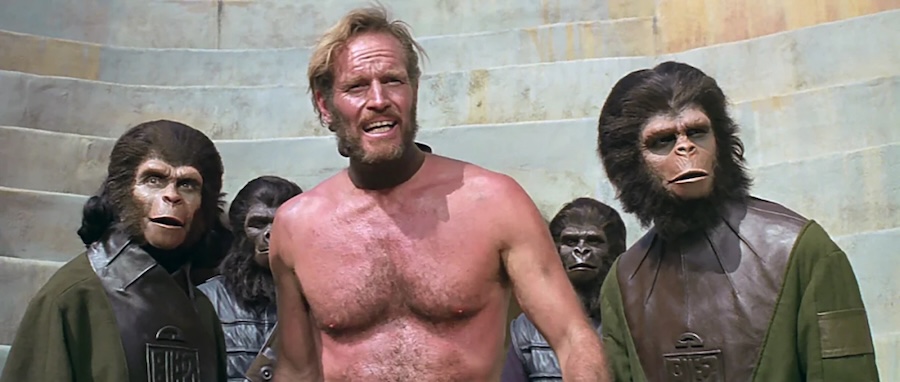
SOMEWHERE IN THE UNIVERSE THERE MUST BE SOMETHING BETTER THAN MAN. IN A MATTER OF TIME, AN ASTRONAUT WILL WING THROUGH THE CENTURIES AND FIND THE ANSWER. HE MAY FIND THE MOST TERRIFYING ONE OF ALL ON THE PLANET WHERE APES ARE THE RULERS AND MAN THE BEAST.

The basic concept of this wildly successful movie is Pierre Boulle’s idea of a future where space travelers end up on an Earth-like planet near the actual Betelgeuse star and learn that nature’s order has been upset. The bizarre theme would have been perfect for an episode of the 1960s TV series The Twilight Zone. And, in fact, the show’s creator Rod Serling did adapt the novel, but not for the show. He turned the story into a screenplay and came up with the brilliant twist in the end.
However, since Serling’s elaborate vision of a very advanced society run by apes would have cost too much to realize, his original script was rejected. Blacklisted writer Michael Wilson was brought in and made the apes’ world a lot more primitive, adding an intriguing brutality. Both men certainly deserve credit for the final result.
Leaving Earth in 1972
Three men, including George Taylor (Charlton Heston), and one woman leave Earth in 1972 on board a spacecraft. After going into deep hibernation, the astronauts are awakened when the ship crashes into a lake on an unknown planet. The female astronaut died in her sleep, but the three men leave the ship to explore the planet. They know that they’ve traveled through time and that the year is AD 3978. Everyone they ever knew has been dead for thousands of years, but it isn’t a big deal to Taylor who didn’t leave anyone close behind. Soon the astronauts find a group of primitive humans, including an attractive girl whom Taylor names Nova (Linda Harrison). But they also learn that the humans are hunted – by talking apes who are clothed, ride horses and carry weapons.
Raw and mysterious music score
Technically speaking, Planet of the Apes is very impressive. Composer Jerry Goldsmith wrote an experimental, raw and mysterious music score that quickly becomes one of the filmmakers’ most effective tools in the process of making the audience believe in this strange upside-down world. John Chambers and his team of makeup artists created special ape masks for the actors that looked more real than anything we had seen; flexible and organic, the masks helped the cast create real characters out of their apes, with a wide variety of expressions.
The shocker of an ending, often parodied since, brings new depth to the whole story.
Cinematographer Leon Shamroy instilled a sense of unease in us, with sudden movements and close-ups meant to unsettle the audience, as if underscoring Heston’s confusion in trying to figure out how this new society works. The film’s final special-effects shot, so famous now, was achieved with a matte painting that looks convincing; this shocker of an ending, often parodied since, brings new depth to the whole story. It also brings home the critique of civilization that runs as a theme throughout the film, telling us that the world we take for granted may not last unless we do everything we can to avoid racism and worldwide military aggression. The foolish, fearful and arrogant behavior of the apes, as represented by Dr. Zaius (Maurice Evans), is meant to mirror that of the white man’s.
But the movie is also about sheer thrills, simply put. Just like Heston’s astronaut, we’re learning about this world for the first time and are quickly caught up in his battle to save himself. The cocky Taylor may not be instantly likable, but he’s clearly human. His simian allies are sweet and very well played by Roddy McDowall and Kim Hunter, who would return in subsequent films.
The franchise certainly has staying power. Tim Burton’s mediocre remake in 2001 was ridiculed, but there’s new life in the reboot; my expectations are high for the third film in that series, set to premiere summer 2017. Still, it’s hard to beat the stylish original.
Planet of the Apes 1968-U.S. 112 min. Color. Widescreen. Directed by Franklin J. Schaffner. Screenplay: Michael Wilson, Rod Serling. Novel: Pierre Boulle. Cinematography: Leon Shamroy. Music: Jerry Goldsmith. Cast: Charlton Heston (George Taylor), Roddy McDowall (Cornelius), Kim Hunter (Zira), Maurice Evans, James Whitmore, James Daly.
Trivia: Edward G. Robinson and Ursula Andress were considered for roles; Blake Edwards for directing duties. John Chambers received an honorary Oscar for his makeup. Followed by four sequels, starting with Beneath the Planet of the Apes (1970), and two TV series, Planet of the Apes (1974) and Return to the Planet of the Apes (1975). Remade as Planet of the Apes (2001). The franchise was rebooted as Rise of the Planet of the Apes (2011).
Quote: “Take your stinking paws off me, you damned dirty ape!” (Heston)
Last word: “The parts in a science fiction film tend to fall into three categories: monsters, in which you are merely a vehicle for the makeup; the pointers, who usually appear in pictures like Destination Moon and 2001, in which you’re seeing these amazing sights, and you say, ‘Hey, look at that!,’ and point; and the fugitives, who are in the more horrifying films, in which you’re running away from the creature from the black lagoon or something, and you say, ‘Look out, here it comes again!’ Those really don’t offer much creative satisfaction for the actor, but Planet of the Apes offered an acting role, Taylor, the astronaut who is physically fleeing Earth because of his contempt for man as a generally unsatisfactory animal.” (Heston, Cinefantastique)
